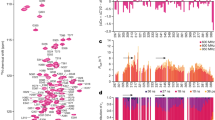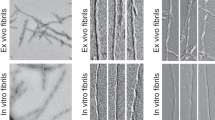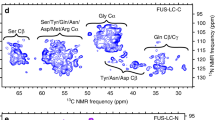Abstract
Diffusible subfibrillar aggregates of amyloid proteins are potent neurotoxins and primary suspects in amyloid diseases including Alzheimer's disease. Despite widespread interest, the molecular structures of the amyloid intermediates and the conformational conversions in amyloid misfolding are poorly understood. Here we present a molecular-level examination of sequence-specific secondary structures and supramolecular structures of a neurotoxic amyloid intermediate of the 40-residue β-amyloid (Aβ) peptide involved in Alzheimer's disease. Using solid-state NMR and electron microscopy, we show that, before fibrillization, natively unstructured monomeric Aβ is subject to large conformational changes into a spherical amyloid intermediate of 15–35 nm diameter, which has predominantly parallel β-sheet structures. Structural comparison with Aβ fibrils demonstrates that formation of this β-sheet intermediate (Iβ) largely defines conformational transitions in amyloid misfolding. Neurotoxicity assays on PC12 cells show that Iβ shows higher toxicity than the fibril, indicating that the β-sheet formation may trigger neurotoxicity.
This is a preview of subscription content, access via your institution
Access options
Subscribe to this journal
Receive 12 print issues and online access
$189.00 per year
only $15.75 per issue
Buy this article
- Purchase on Springer Link
- Instant access to full article PDF
Prices may be subject to local taxes which are calculated during checkout





Similar content being viewed by others
References
Selkoe, D.J. Cell biology of protein misfolding: the examples of Alzheimer's and Parkinson's diseases. Nat. Cell Biol. 6, 1054–1061 (2004).
Caughey, B. & Lansbury, P.T. Protofibrils, pores, fibrils, and neurodegeneration: Separating the responsible protein aggregates from the innocent bystanders. Annu. Rev. Neurosci. 26, 267–298 (2003).
Sunde, M. & Blake, C.C.F. From the globular to the fibrous state: protein structure and structural conversion in amyloid formation. Q. Rev. Biophys. 31, 1–39 (1998).
Dobson, C.M. Protein folding and misfolding. Nature 426, 884–890 (2003).
Bucciantini, M. et al. Inherent toxicity of aggregates implies a common mechanism for protein misfolding diseases. Nature 416, 507–511 (2002).
Lorenzo, A. & Yankner, B.A. β-amyloid neurotoxicity requires fibril formation and is inhibited by Congo red. Proc. Natl. Acad. Sci. USA 91, 12243–12247 (1994).
Walsh, D.M., Lomakin, A., Benedek, G.B., Condron, M.M. & Teplow, D.B. Amyloid β-protein fibrillogenesis—detection of a protofibrillar intermediate. J. Biol. Chem. 272, 22364–22372 (1997).
Lambert, M.P. et al. Diffusible, nonfibrillar ligands derived from Aβ1–42 are potent central nervous system neurotoxins. Proc. Natl. Acad. Sci. USA 95, 6448–6453 (1998).
Hoshi, M. et al. Spherical aggregates of (β-amyloid (amylospheroid) show high neurotoxicity and activate tau protein kinase I/glycogen synthase kinase-3β. Proc. Natl. Acad. Sci. USA 100, 6370–6375 (2003).
Nilsberth, C. et al. The 'Arctic' APP mutation (E693G) causes Alzheimer's disease by enhanced Aβ protofibril formation. Nat. Neurosci. 4, 887–893 (2001).
Lashuel, H.A. et al. Mixtures of wild-type and a pathogenic (E22G) form of Aβ40 in vitro accumulate protofibrils, including amyloid pores. J. Mol. Biol. 332, 795–808 (2003).
Conway, K.A. et al. Acceleration of oligomerization, not fibrillization, is a shared property of both α-synuclein mutations linked to early-onset Parkinson's disease: Implications for pathogenesis and therapy. Proc. Natl. Acad. Sci. USA 97, 571–576 (2000).
McLean, C.A. et al. Soluble pool of Aβ amyloid as a determinant of severity of neurodegeneration in Alzheimer's disease. Ann. Neurol. 46, 860–866 (1999).
Lue, L.F. et al. Soluble amyloid β peptide concentration as a predictor of synaptic change in Alzheimer's disease. Am. J. Pathol. 155, 853–862 (1999).
Hsia, A.Y. et al. Plaque-independent disruption of neural circuits in Alzheimer's disease mouse models. Proc. Natl. Acad. Sci. USA 96, 3228–3233 (1999).
Walsh, D.M. et al. Naturally secreted oligomers of amyloid β protein potently inhibit hippocampal long-term potentiation in vivo. Nature 416, 535–539 (2002).
Lesne, S. et al. A specific amyloid-β protein assembly in the brain impairs memory. Nature 440, 352–357 (2006).
Kirkitadze, M.D., Condron, M.M. & Teplow, D.B. Identification and characterization of key kinetic intermediate in amyloid β-protein fibrillogenesis. J. Mol. Biol. 312, 1103–1119 (2001).
Krishnan, R. & Lindquist, S.L. Structural insights into a yeast prion illuminate nucleation and strain diversity. Nature 435, 765–772 (2005).
Liu, K., Cho, H.S., Lashuel, H.A., Kelly, J.W. & Wemmer, D.E. A glimpse of a possible amyloidogenic intermediate of transthyretin. Nat. Struct. Biol. 7, 754–757 (2000).
Jahn, T.R., Parker, M.J., Homans, S.W. & Radford, S.E. Amyloid formation under physiological conditions proceeds via a native-like folding intermediate. Nat. Struct. Mol. Biol. 13, 195–201 (2006).
Eakin, C.M., Berman, A.J. & Miranker, A.D. A native to amyloidogenic transition regulated by a backbone trigger. Nat. Struct. Mol. Biol. 13, 202–208 (2006).
Dobson, C.M. An accidental breach of a protein's natural defenses. Nat. Struct. Mol. Biol. 13, 295–297 (2006).
Chromy, B.A. et al. Self-assembly of Aβ(1–42) into globular neurotoxins. Biochemistry 42, 12749–12760 (2003).
Chimon, S. & Ishii, Y. Capturing intermediate structures of Alzheimer's β-amyloid, Aβ(1–40), by solid-state NMR spectroscopy. J. Am. Chem. Soc. 127, 13472–13473 (2005).
Shearman, M.S. Toxicity of protein aggregates in PC12 cells: 3-(4,5-dimethylthiazol-2-yl)-2,5-diphenyltetrazolium bromide assay. Methods Enzymol. 309, 716–723 (1999).
Kayed, R. et al. Common structure of soluble amyloid oligomers implies common mechanism of pathogenesis. Science 300, 486–489 (2003).
Lansbury, P.T. et al. Structural model for the β-amyloid fibril based on interstrand alignment of an antiparellel-sheet comprising a c-terminal peptide. Nat. Struct. Biol. 2, 990–998 (1995).
Petkova, A.T. et al. A structural model for Alzheimer's β-amyloid peptide fibrils based on experimental constraints from solid-state NMR spectroscopy. Proc. Natl. Acad. Sci. USA 99, 16742–16747 (2002).
Jaroniec, C.P., MacPhee, C.E., Astrof, N.S., Dobson, C.M. & Griffin, R.G. Molecular conformation of a peptide fragment of transthyretin in an amyloid fibril. Proc. Natl. Acad. Sci. USA 99, 16748–16753 (2002).
Heise, H. et al. Molecular-level secondary structure, polymorphism, and dynamics of full-length α-synuclein fibrils studied by solid-state NMR. Proc. Natl. Acad. Sci. USA 102, 15871–15876 (2005).
Ritter, C. et al. Correlation of structural elements and infectivity of the HET-s prion. Nature 435, 844–848 (2005).
Benzinger, T.L.S. et al. Propagating structure of Alzheimer's β-amyloid(10–35) is parallel β-sheet with residues in exact register. Proc. Natl. Acad. Sci. USA 95, 13407–13412 (1998).
Weliky, D.P. et al. Solid-state NMR evidence for an antibody-dependent conformation of the V3 loop of HIV-1 gp120. Nat. Struct. Biol. 6, 141–145 (1999).
Igumenova, T.I. et al. Assignments of carbon NMR resonances for microcrystalline ubiquitin. J. Am. Chem. Soc. 126, 6720–6727 (2004).
Castellani, F. et al. Structure of a protein determined by solid-state magic-angle- spinning NMR spectroscopy. Nature 420, 98–102 (2002).
Lange, A. et al. Toxin-induced conformational changes in a potassium channel revealed by solid-state NMR. Nature 440, 959–962 (2006).
Studelska, D.R., McDowell, L.M., Espe, M.P., Klug, C.A. & Schaefer, J. Slowed enzymatic turnover allows characterization of intermediates by solid-state NMR. Biochemistry 36, 15555–15560 (1997).
Saito, H. Conformation-dependent 13C chemical shifts: a new means of conformational characterization as obtained by high-resolution solid-state NMR. Magn. Reson. Chem. 24, 835–852 (1986).
Spera, S. & Bax, A. Empirical correlation between protein backbone conformation and C-α and C-β C-13 nuclear-magnetic-resonance chemical shifts. J. Am. Chem. Soc. 113, 5490–5492 (1991).
Ishii, Y. 13C–13C dipolar recoupling under very fast magic angle spinning in solid-state NMR: Applications to distance measurements, spectral assignments, and high-throughput secondary-structure elucidation. J. Chem. Phys. 114, 8473–8483 (2001).
Petkova, A.T. et al. Self-propagating, molecular-level polymorphism in Alzheimer's β-amyloid fibrils. Science 307, 262–265 (2005).
Wishart, D.S., Bigam, C.G., Holm, A., Hodges, R.S. & Sykes, B.D. 1H, 13C and 15N random coil NMR chemical shifts of the common amino acids. I. Investigations of nearest-neighbor effects. J. Biomol. NMR 5, 67–81 (1995).
Cornilescu, G., Delaglio, F. & Bax, A. Protein backbone angle restraints from searching a database for chemical shift and sequence homology. J. Biomol. NMR 13, 289–302 (1999).
Petkova, A.T., Yau, W.M. & Tycko, R. Experimental constraints on quaternary structure in Alzheimer's β-amyloid fibrils. Biochemistry 45, 498–512 (2006).
Levine, H., III Quantification of β-sheet amyloid fibril structures with thioflavin T. Methods Enzymol. 309, 274–284 (1999).
Naiki, H., Gejyo, F. & Nakakuki, K. Concentration-dependent inhibitory effects of apolipoprotein E on Alzheimer's β-amyloid fibril formation in vitro. Biochemistry 36, 6243–6250 (1997).
Reches, M. & Gazit, E. Casting metal nanowires within discrete self-assembled peptide nanotubes. Science 300, 625–627 (2003).
Zhang, S. Fabrication of novel biomaterials through molecular self-assembly. Nat. Biotechnol. 21, 1171–1178 (2003).
Lambert, M.P. et al. Vaccination with soluble Aβ oligomers generates toxicity-neutralizing antibodies. J. Neurochem. 79, 595–605 (2001).
Acknowledgements
We thank M. Rasenick and J.-Z. Yu (University of Illinois at Chicago) for the PC-12 cells; L. Juarez and B. Lee for assistance with TEM studies and peptide synthesis, respectively; C. Bhardwaj, W. Cho and members of his group, and G. Fenteany for assistance with the neurotoxicity assay; R. Tycko for the structural model of Aβ1–40 used in Fig. 4b and C. Jameson, T. Keiderling and W. Klein for suggestions. This work was supported in part by the Alzheimer's Association (NIRG 035123), the Dreyfus Foundation Teacher-Scholar Award program, the US National Science Foundation CAREER program (CHE 449952), and the National Institutes of Health RO1 program (AG028490).
Author information
Authors and Affiliations
Corresponding author
Supplementary information
Supplementary Text and Figures
Supplementary Methods, Supplementary Data, Supplementary Figures 1–7 and Supplementary Table 1 (PDF 1096 kb)
Rights and permissions
About this article
Cite this article
Chimon, S., Shaibat, M., Jones, C. et al. Evidence of fibril-like β-sheet structures in a neurotoxic amyloid intermediate of Alzheimer's β-amyloid. Nat Struct Mol Biol 14, 1157–1164 (2007). https://doi.org/10.1038/nsmb1345
Received:
Accepted:
Published:
Issue Date:
DOI: https://doi.org/10.1038/nsmb1345
This article is cited by
-
Rectifying disorder of extracellular matrix to suppress urethral stricture by protein nanofilm-controlled drug delivery from urinary catheter
Nature Communications (2023)
-
Early events in amyloid-β self-assembly probed by time-resolved solid state NMR and light scattering
Nature Communications (2023)
-
C3N nanodots inhibits Aβ peptides aggregation pathogenic path in Alzheimer’s disease
Nature Communications (2023)
-
Dual-probe fluorescence spectroscopy for sensitive quantitation of Alzheimer’s amyloid pathology
Acta Neuropathologica Communications (2022)
-
Discovery of a novel pseudo β-hairpin structure of N-truncated amyloid-β for use as a vaccine against Alzheimer’s disease
Molecular Psychiatry (2022)



